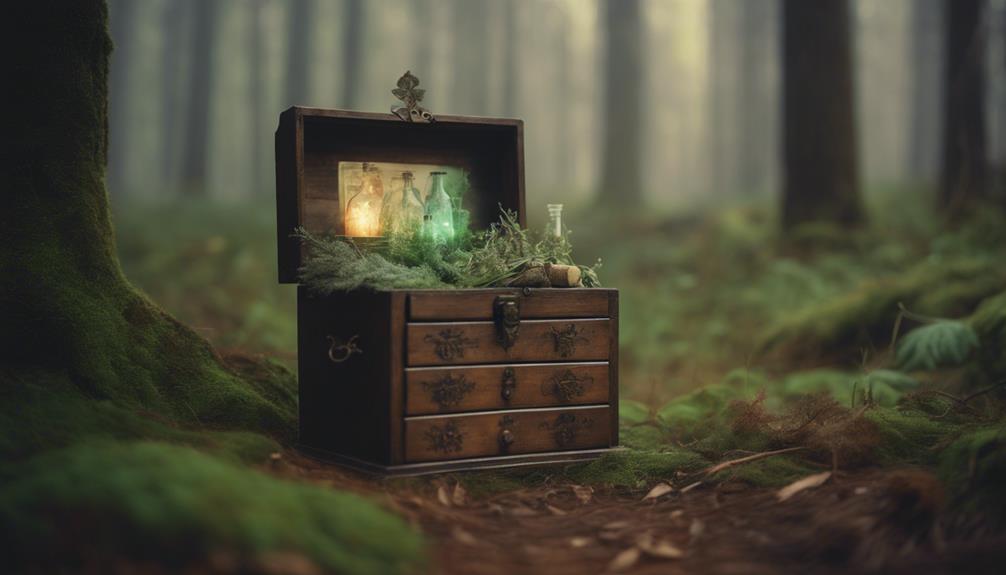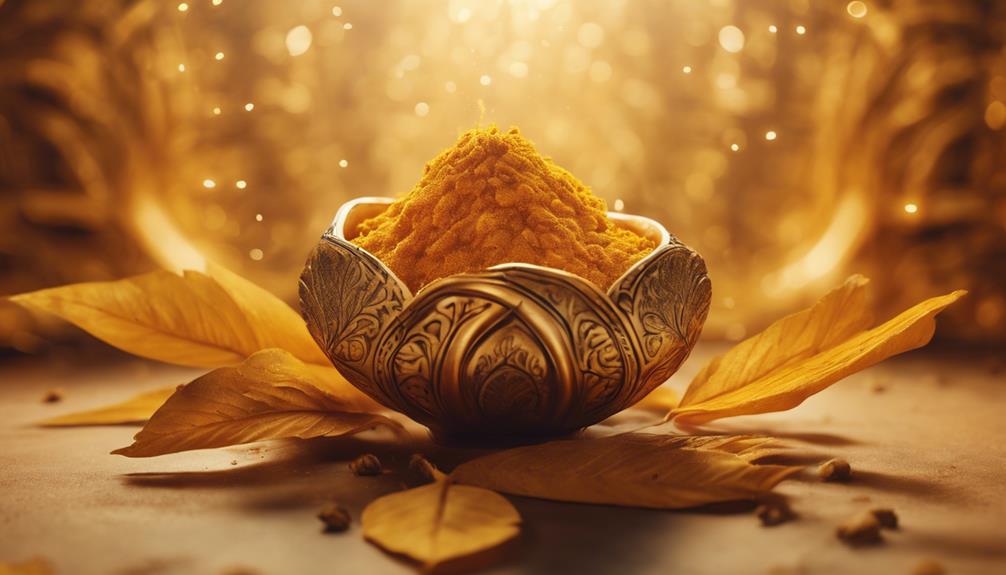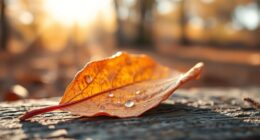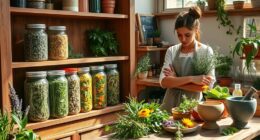We engage in spiritual herbalism by recognizing the reciprocal relationships between plants, people, and the natural world, acknowledging the spiritual essence of plants to access their transformative power for healing and growth. We honor the interconnectedness of our physical body, spirit, and soul, and understand that true balance is achieved when these aspects are in harmony. By working with plant spirits and energies, we can tap into their wisdom and guidance, using ancient practices to awaken our full potential. As we explore the mysteries of spiritual herbalism, we uncover the secrets to holistic healing and spiritual elevation.
Key Takeaways
• Spiritual herbalism involves acknowledging plants as key to accessing highest potential and balancing physical, emotional, and spiritual bodies.
• It taps into plant wisdom, recognizing their consciousness, intelligence, and spiritual properties for healing, growth, and transformation.
• This practice investigates the mysteries of plants, honoring ancient wisdom and diasporic ancestral traditions for guiding towards a healing path.
• Spiritual herbalism connects with the natural world, recognizing the intelligence and awareness of plants to access their transformative powers.
• It involves using intentional rituals, ceremonies, and meditations to connect with plant spirits, harnessing their full potential for spiritual elevation and self-discovery.
Understanding Spiritual Herbalism Practices
As we explore the world of spiritual herbalism, we find that understanding the intricacies of this practice requires a profound appreciation for the reciprocal relationships between plants, people, and the natural world.
We're not just talking about using plants to treat physical symptoms, but rather acknowledging the spiritual essence of these living beings and their potential to heal on a deeper level.
In spiritual herbalism, plants are recognized for their consciousness and intelligence, which enables them to respond to their environment and develop strong immunity. This unique connection allows plants to offer emotional, mental, and spiritual healing, going beyond just physical remedies.
By acknowledging the interconnectedness of our physical body, spirit, and soul, spiritual herbalism provides a holistic approach to healing.
As we explore further into this practice, we begin to understand that healing isn't just about alleviating physical ailments, but also about balancing our spiritual and emotional well-being.
Working With Plant Spirits and Energies

We explore the mystical domain of spiritual herbalism, where the boundaries between humans and plants blur, and the essence of botanicals is harnessed to facilitate profound healing and transformation. As we investigate further into this sphere, we recognize the significance of working with plant spirits and energies.
In spiritual herbalism, we believe that plants possess unique energies that can influence our physical, emotional, and spiritual well-being.
Here are some key aspects of working with plant spirits and energies:
- We engage in rituals, ceremonies, and meditations to connect with plant spirits, fostering a deeper understanding of their essence and properties.
- By honoring the spiritual aspects of plants, we tap into their transformative power, accelerating our healing journey.
- We acknowledge that plants aren't just physical entities, but also possess a spiritual consciousness that can guide and support us.
- Through spiritual herbalism, we can access the subtle dimensions of plant energies, revealing their full potential for healing and growth.
- By acknowledging the interconnectedness of all living beings, we can harness the collective wisdom of the plant kingdom to elevate our spiritual consciousness.
Ancient Wisdom for Modern Healing

By tapping into the ancient wisdom of spiritual herbalism, we reveal the secrets of holistic healing, merging the spiritual and physical properties of plants to address modern health concerns.
We're not just talking about physical symptoms; we're talking about healing on a deeper level. Spiritual herbalism guides us in using plants for spiritual growth, protection, and intuition.
It's an ancestral practice that's been passed down through generations, and it's still relevant today.
Balancing Body and Soul With Herbs

In our pursuit of holistic wellness, we turn to herbal remedies that not only soothe our physical bodies but also nurture our spiritual selves, recognizing that true balance is only achievable when both are in harmony.
By incorporating herbalism into our self-care routines, we can address emotional, mental, and spiritual imbalances that may be affecting our overall well-being.
Some ways we can balance our body and soul with herbs include:
- Using adaptogenic herbs like ashwagandha to reduce stress and anxiety
- Creating calming tea blends with herbs like chamomile and lavender to soothe the emotional body
- Incorporating herbs like turmeric and ginger into our diets to reduce inflammation and promote spiritual growth
- Using herbalism to connect with nature and the natural world, promoting a sense of spiritual connection
- Practicing mindfulness and intention when working with herbs to amplify their spiritual properties
The Art of Plant-Based Rituals

As we explore the world of spiritual herbalism, we find that plant-based rituals offer a profound means of connecting with the natural world and harnessing the transformative power of plants. These rituals guide us in utilizing the magic of plants to heal emotional and spiritual wounds. By incorporating sacred ceremonies, prayers, and intention setting, we can tap into the energetic and vibrational properties of plants, facilitating transformation and growth.
| Ritual | Purpose | Benefits |
|---|---|---|
| Herbal Baths | Relaxation, Purification | Calms the mind, soothes the body |
| Smudging | Protection, Cleansing | Clears negative energy, promotes positivity |
| Herbal Sachets | Guidance, Protection | Offers emotional support, wards off negativity |
In spiritual herbalism, we learn to reverence the healing power of plants, recognizing their ability to heal emotional and spiritual imbalances. By harnessing the power of plants, we can create a deeper connection with the natural world and explore the full potential of plant-based rituals. As we investigate further into the art of plant-based rituals, we discover a profound tool for personal growth, healing, and spiritual evolution.
Herbal Remedies for Spiritual Growth
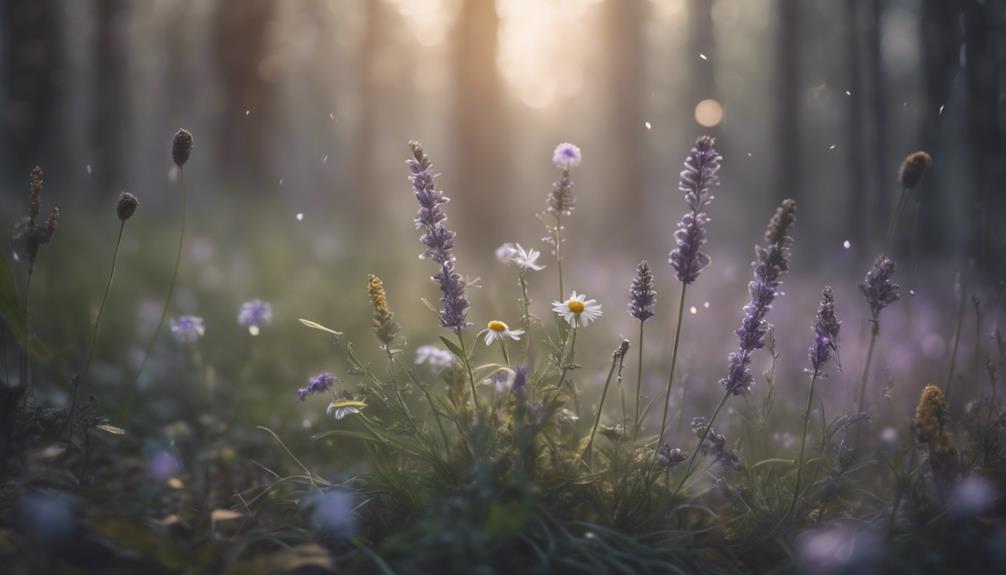
We turn to herbal remedies as a powerful means of catalyzing spiritual growth, recognizing the profound impact that plants can have on our emotional, spiritual, and intuitive well-being. As we delve into the world of spiritual herbalism, we're reminded of the Power of Plants to address emotional and spiritual imbalances.
By harnessing the energetic and spiritual properties of plants, we can tap into the ancient wisdom of ancestral practices in remedies.
Some ways herbal remedies support spiritual growth include:
- Balancing emotions: Plants like chamomile and lavender calm the mind and soothe the heart, allowing us to connect with our emotions on a deeper level.
- Enhancing intuition: Herbs like sage and peppermint stimulate our intuitive senses, helping us tap into our inner wisdom.
- Strengthening connection to nature: Rituals and plants help us reconnect with the natural world, fostering a sense of oneness with the universe.
- Addressing spiritual imbalances: Plants like ashwagandha and rhodiola help alleviate stress and anxiety, promoting spiritual balance and harmony.
- Amplifying rituals and ceremonies: Herbs like frankincense and myrrh are used in sacred rituals to amplify their spiritual effects, promoting a deeper connection with the divine.
Navigating the Spiritual Pharmacy
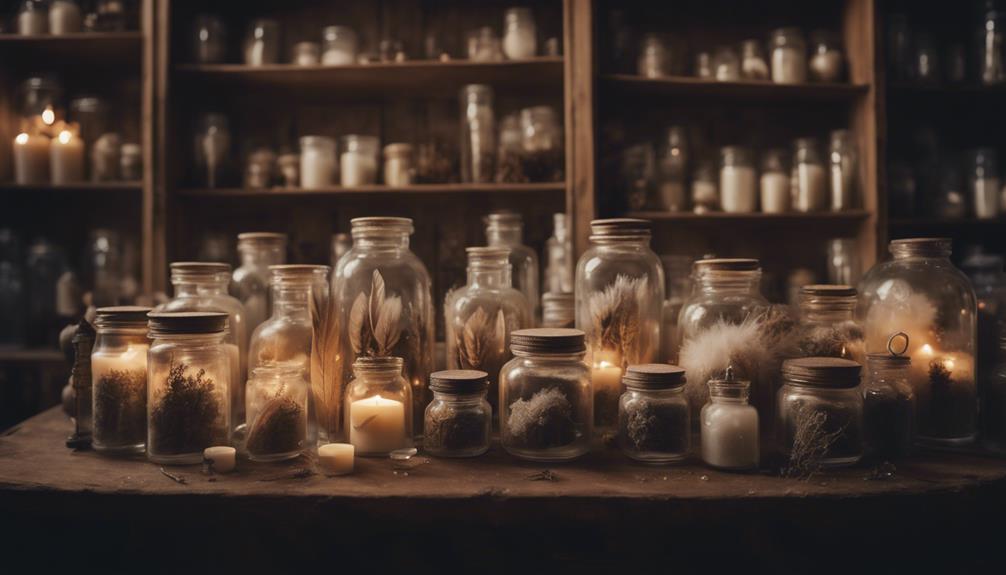
As we navigate the spiritual pharmacy, we're about to explore the essential points that will guide us in our journey.
We'll discover how to access the power of herbal allies for wellness, tap into the sacred plant energetics that resonate with our soul, and create meaningful rituals for connection with nature and ourselves.
Herbal Allies for Wellness
In the spiritual pharmacy, we select herbal allies based on their unique energetic signatures and vibrational properties, which resonate with our individual needs and support our holistic well-being. This approach acknowledges that plants possess a consciousness and wisdom that can guide the process of healing and growth.
By honoring the spiritual properties of herbs, we can create personalized formulations that alleviate physical symptoms and promote spiritual growth.
Some key aspects of working with herbal allies for wellness include:
- Recognizing the ancestral wisdom embedded in plants, which can help us connect with our own heritage and the natural world
- Understanding how plants can bridge the gap between spiritual and physical dimensions, facilitating balance and harmony
- Selecting herbs that resonate with our unique energy and needs, rather than relying on a one-size-fits-all approach
- Working with plants that can help us access and process emotions, leading to deeper healing and self-awareness
- Embracing the idea that plants aren't just remedies, but also teachers and guides on our journey towards wellness and self-discovery
Sacred Plant Energetics
By exploring the spiritual pharmacy, I tap into the transformative powers of plants, revealing their secrets to access profound healing and growth. Sacred Plant Energetics is an integral part of Spiritual Herbalism, where we delve into the spiritual essence and consciousness of plants beyond their physical properties. This approach combines science and spirit to create powerful remedies for holistic healing.
| Aspect | Description | Importance |
|---|---|---|
| Spiritual Essence | Plants' spiritual properties | Access to transformative powers |
| Ancestral Magic | Plants' ancient wisdom | Connection to the natural world |
| Herbal Medicine | Plants' physical properties | Healing the physical body |
Rituals for Connection
We enter the spiritual pharmacy through rituals that honor the energetic properties of herbs, allowing us to tap into their transformative powers. These rituals help us connect with the spiritual essence of plants, exploring the spiritual pharmacy and accessing the subtle energies and healing powers of plants. By engaging in these rituals, we can establish a deeper connection with plant spirits and access the underlying emotional and spiritual roots of our symptoms.
Some of the rituals we use to connect with plants include:
- Meditation to quiet the mind and tune into the plant's energy
- Prayer to set intentions and invoke the plant's healing powers
- Intention setting to clarify our goals and focus our energy
- Energetic attunement to harmonize our energy with the plant's energy
- Gratitude practices to honor the plant's wisdom and generosity
Through these rituals, plants help us uncover the underlying causes of our symptoms and support us in the process of transformation. By honoring the spiritual essence of plants, we can tap into their transformative powers and access the healing energies that lie within.
The Power of Intention in Healing
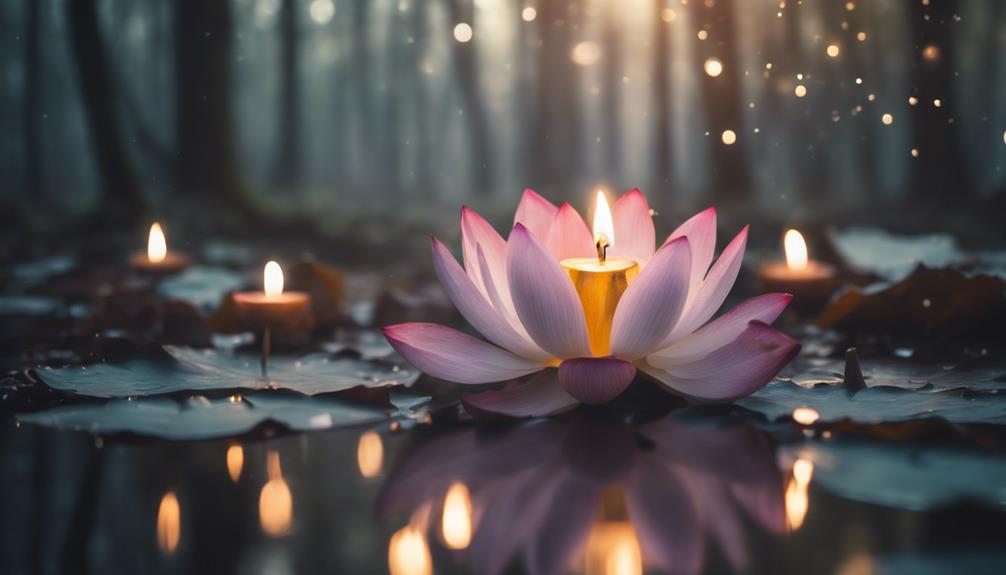
As we explore the power of intention in healing, we recognize that establishing a sacred space is essential for harnessing the energy of herbs.
By creating a mindful environment, we can intentionally focus our energy and attention on the healing process.
Now, let's examine how we can energize herbs with our intention, amplifying their natural healing properties.
Setting Sacred Space
In spiritual herbalism, we deliberately craft a sacred space to harness the power of intention, directing our energy towards healing and transformation. This intentional creation of a safe and energetically conducive environment allows us to focus our minds, emotions, and energies towards the desired outcome of the healing process.
To establish this sacred space, we engage in rituals, prayers, meditation, or specific ceremonies that connect us with the divine, plant spirits, ancestors, and guides. This connection provides us with guidance and support throughout our healing journey.
Some ways we set sacred space include:
- Purifying the space with smudging or sound healing
- Creating an altar with intentional symbols and objects
- Inviting the presence of guides and ancestors
- Setting a clear intention for the healing process
- Using specific herbs and crystals to amplify the energy
Energizing Herbs
By deliberately infusing herbs with intention, we enhance their healing properties and deepen our spiritual connection to the natural world. As spiritual herbalists, we recognize the significance of intention in healing, and we harness it to amplify the effectiveness of our herbal remedies.
By setting a clear intention, we can tap into the intrinsic energy of the herbs, making them more potent and targeted in their healing action. This intentional approach not only enhances the healing properties of the herbs but also fosters a deeper spiritual connection between us and the natural world.
As we infuse herbs with specific intentions, we create a synergy that magnifies their therapeutic potential. The practitioner's intention, in this sense, plays a vital role in shaping the energy and effectiveness of the herbal remedy.
Embracing the Mystical in Herbalism
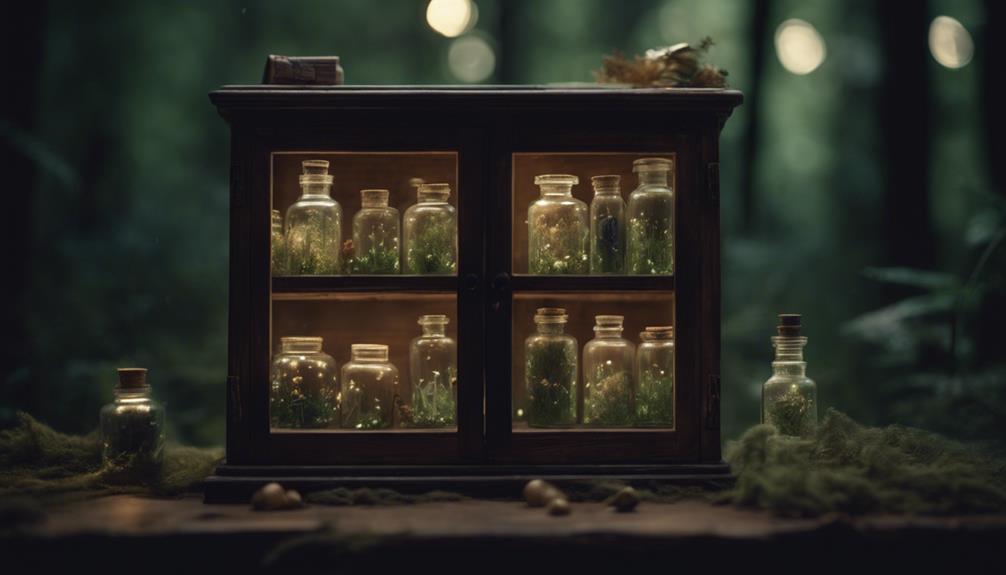
We explore the mystical world of herbalism, where the ancient wisdom of plants whispers secrets of the universe. As we venture further, we discover that spiritual herbalism isn't just about healing the physical body, but also about connecting with the mystical essence of plants to transform and heal our emotional and spiritual selves.
In this domain, we tap into the magic of plants, acknowledging their consciousness and spiritual properties that go beyond their physical healing benefits. We incorporate diasporic ancestral practices, honoring the wisdom of our ancestors and the land. As a practical tool for working with plant medicine, spiritual herbalism helps us address symptoms or heal emotional wounds by balancing our physical, emotional, and spiritual energies.
We connect with the spiritual essence of plants to access their mystical properties.
We honor the wisdom of our ancestors and the land through diasporic ancestral practices.
We use plant medicine as a practical tool for addressing emotional and spiritual imbalances.
We tap into the magic of plants to access their transformative power.
We acknowledge the consciousness and spiritual properties of plants beyond their physical benefits.
Unlocking the Potential of Plants
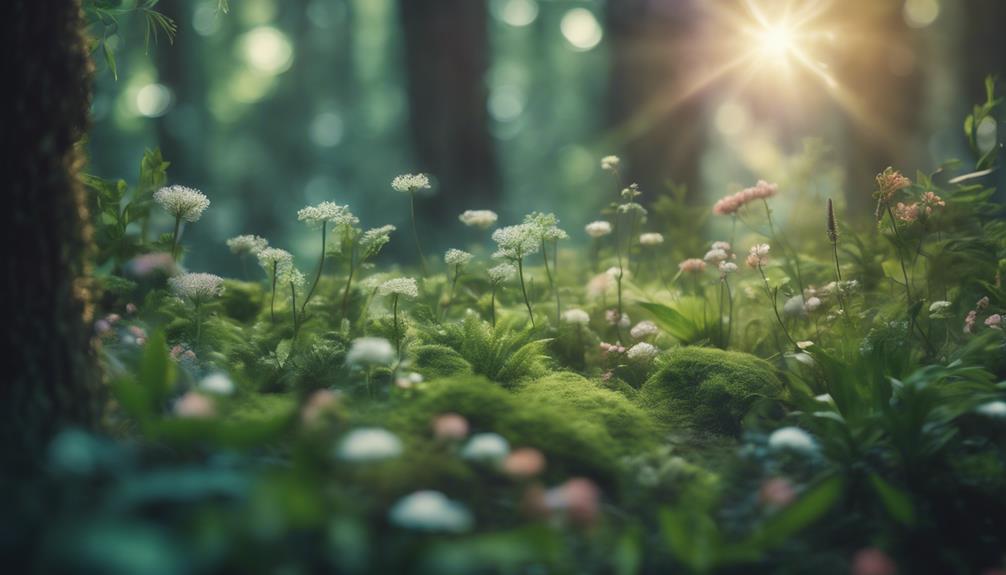
As we delve into the world of spiritual herbalism, we're about to uncover the hidden treasures of plants, and it starts with understanding their energetic properties.
We'll tap into the ancient wisdom of herbalists who've long recognized the unique virtues of each plant, allowing us to harness their full potential.
Plant Energetic Properties
In the domain of spiritual herbalism, we discover that plants possess unique vibrations and energies that can be harnessed for healing and spiritual growth. By accessing these subtle energies, we can unleash the full potential of plants to facilitate transformation and balance in individuals. This understanding goes beyond the physical attributes of plants, delving into their spiritual aspects to enhance the healing journey.
Some key aspects of plant energetic properties include:
- Recognizing that plants can help alleviate symptoms of body disease by addressing the root causes of imbalance
- Honoring the ancestral wisdom of plants and diasporic ancestral traditions in our herbal apothecary practices
- Using the power of intentional rituals and ceremonies to amplify the effects of plant medicine
- Tapping into the subtle energies of plants to access their ancient wisdom and healing potential
- Embracing the concept that plants aren't just physical entities, but also spiritual allies that can guide us on our path to wellness and self-discovery
Herbalist's Ancient Wisdom
By tapping into the subtle energies of plants, we uncover the secrets of ancient wisdom, where the consciousness of plants reveals their intelligence, awareness, and profound healing properties.
As spiritual herbalists, we comprehend that plants could be used not only for their physical attributes but also for their spiritual essence.
We explore the rituals, practices, and ceremonies that connect us with the spiritual essence of plants, revealing their transformative and healing powers.
Black herbalist Karen, for instance, has spent years studying the ancient wisdom of plants, using their consciousness to guide her in her healing practices. By doing so, she brings oneself back to the natural world, recognizing the intelligence and awareness of plants.
In spiritual herbalism, we acknowledge that plants hold the key to accessing our highest potential, and by tapping into their wisdom, we can bring balance to our physical, emotional, and spiritual bodies.
As we continue to investigate the mysteries of plants, we come to realize that their ancient wisdom holds the power to guide us towards a path of healing, growth, and transformation.
Frequently Asked Questions
What Is a Spiritual Herbalist?
As we explore the world of spiritual herbalism, we're often asked: what's a spiritual herbalist? Essentially, we're practitioners who combine herbal medicine with spiritual practices and beliefs to facilitate holistic healing.
We don't just focus on physical health; we also address emotional, mental, and spiritual imbalances by working with plants that possess energetic properties. By honoring nature's intelligence, we tap into the transformative power of plants to promote wellness and spiritual connection.
What Does Herbalism Involve?
As we explore the world of herbalism, we discover it involves more than just using plants for healing. We find that it encompasses a deep understanding of plant properties, energetics, and therapeutic actions.
We learn that herbalism takes a holistic approach to health and wellness, focusing on natural remedies and honoring the interconnectedness of body, spirit, and soul.
What Happens During a Herbalism Session?
During a herbalism session, we discuss physical and emotional imbalances to determine the appropriate plant remedies.
We connect with plants on a spiritual level to access their healing properties.
Our sessions often involve rituals, ceremonies, and plant medicines to facilitate healing and transformation.
We focus on balancing the body, mind, and spirit using plant-based remedies and ancestral wisdom.
What Skills Do You Need to Be a Herbalist?
In addition to that, 80% of the world's population relies on traditional medicine, including herbalism.
As herbalists, we need a multifaceted skill set. We must be able to identify and harvest plants, process and formulate remedies, and understand the body's energy systems and holistic healing principles.
We also develop intuition, connect with nature, and work with plant spirits. Additionally, we cultivate respect for plants, ancestral wisdom, and interconnectedness.
Conclusion
As we immerse ourselves in the world of spiritual herbalism, we find a profound connection between the natural world and our inner selves. By embracing the mystical and ancient wisdom, we access the potential of plants to balance body and soul.
With intention and ritual, we harness the power of plant spirits and energies, exploring the spiritual pharmacy to reveal the secrets of healing.
As we investigate this sacred art, we uncover a deeper understanding of ourselves and the world around us, nurturing a harmonious union of nature and spirit.

